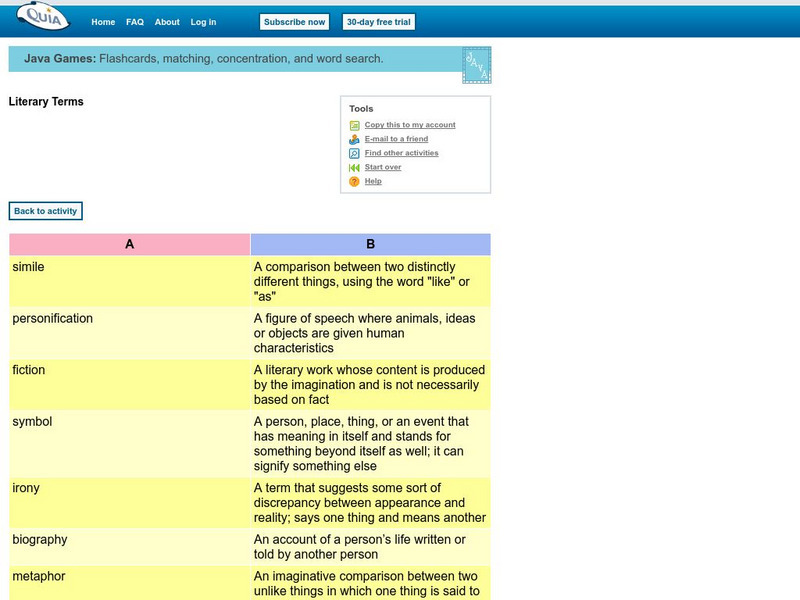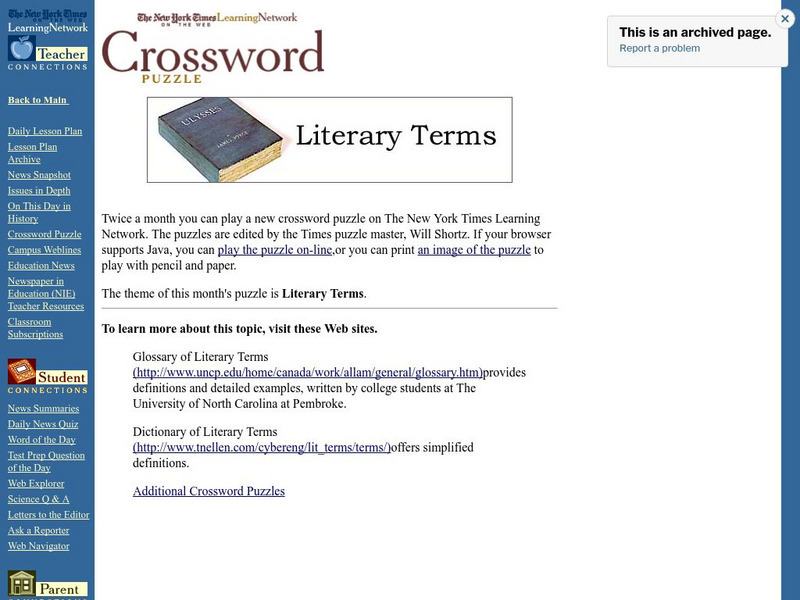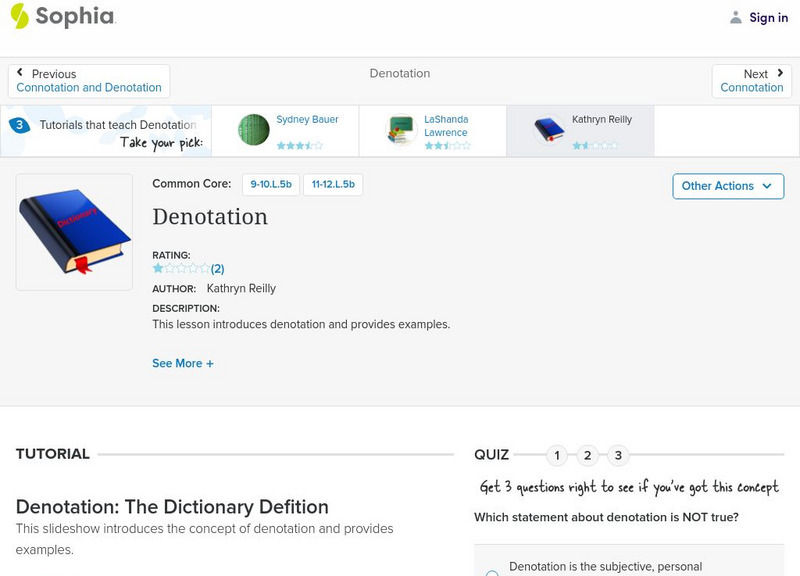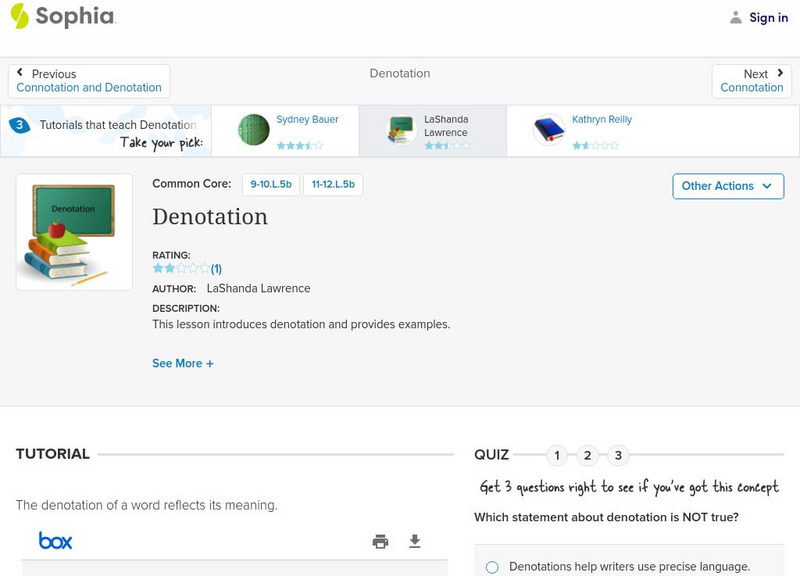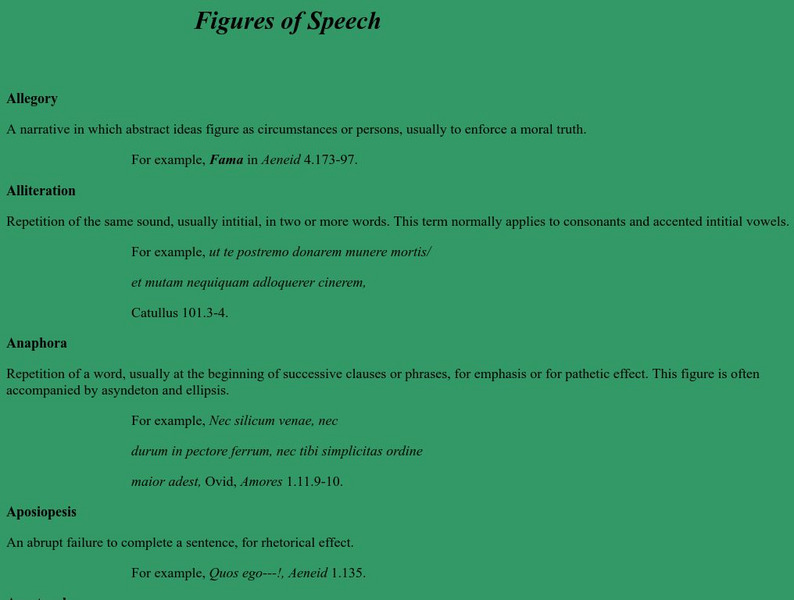Other
Western Michigan University: Writing Papers of Literary Analysis
Lots of great guidelines and rules for writing a literary analysis essay. Areas covered include organization, content, style, and documentation.
Quia
Quia: Prefixes (Matching Game)
Match common prefixes to their meanings in this online matching game.
University of Victoria (Canada)
The U Vic Writer's Guide: Literary Term: Oxymoron
This site from The UVic Writer's Guide provides a brief description of the literary term "oxymoron." Content includes a literary example.
Houghton Mifflin Harcourt
Holt, Rinehart and Winston: Elements of Literature: Ambiguity Chart [Pdf]
A graphic organizer for learning and applying understanding of the literary element of ambiguity. Includes sections in which you list the ambiguity from a given text and its possible interpretations.
Quia
Quia: List of Literary Terms
A list of 28 literary terms with brief, clear definitions. "Nonfiction," is the last term in the list.
New York Times
New York Times: Crossword Puzzle: Literary Terms
An interactive and printable crossword puzzle developed by the New York Times Learning Network. The theme of this puzzle is Literary Terms. Other links are included.
Ted Nellen
Cyber English (By Ted Nellen): Tone
This is a glossary entry for the term "Tone" including a definition and an example.
Ted Nellen
Cyber English (By Ted Nellen): Euphemism
This is a glossary entry for the term "Euphemism" including a definition and examples. L.9-10.5a Figures of Speech
English Club
English Club: Vocabulary: Cloze Games: Business 2
Choose from a word bank to complete ten sentences about terms related to banking. Hints are available if needed, and a percentage score is displayed once answers are submitted.
TES Global
Tes: Varieties of English
[Free Registration/Login Required] This graphic organizer will help student reflect on the similarities and difference among formal and informal word choices. Dialect, idiolect, and verb effectiveness are featured.
ClassFlow
Class Flow: Oxymoron
[Free Registration/Login Required] In this interactive lesson, students will explore how oxymora are used in writing and look at examples. Complete description of this rhetorical effect.
English Club
English Club: What Is English?: History of the English Language
A brief history of the development of the English language including a timeline.
Sophia Learning
Sophia: Denotation
This lesson introduces denotation and provides examples. L.11-12.5b Nuance
Other
Bedford/st. Martin's: Connotation and Denotation
A brief explanation distinguishes connotation from denotation. At the bottom, click on practice exercises. L.11-12.5b Nuance
Sophia Learning
Sophia: Denotation: Lesson 3
This lesson introduces denotation and provides examples. It is 3 of 3 in the series titled "Denotation." CCSS.ELA-Literacy.CCRA.R.4, L.9-10.5b nuances, L.11-12.5b Nuance
Other
Hoocher: Figures of Speech
A list of figures of speech and their definitions with examples from literature.
Ted Nellen
Cyber English (By Ted Nellen): Hyperbole
This is a glossary entry for the figure of speech "Hyperbole" including a definition and examples.
Sophia Learning
Sophia: Connotation and Denotation: Lesson 2
This lesson discusses the difference between connotation and denotation. It is 2 of 2 in the series titled "Connotation and Denotation." L.11-12.5b Nuance
Other
Wise Geek: What Is the Difference Between Alliteration and Assonance?
Information and links to additional information about alliteration, assonance, prose, and consonance.
Vancouver Island University
Vancouver Island University: Literary Terms
Site contains a list of literary terms, including the word "characterization." Basic but accurate definitions are easy to understand.
British Library
British Library: Virtual Reference Library
This site provides links to several on-line dictionaries. Students may desire to consult a few dictionary definitions of their focus term prior to beginning a definition essay.
Love To Know Media
Your Dictionary: High School English Literary Terms
This article focuses on a variety of key literary terms used in high school English including their definitions. These terms include flashback, genre, irony, parody, satire, setting, subplot, tone, and symbol.
Other
The Phrase Finder
Use this tool to find the origins and meanings of phrases, sayings and cliches.
University of Victoria (Canada)
The U Vic Writer's Guide: Literary Term: Soliloquy
This short definition of Soliloquy compares it with a similar literary convention, the "aside."



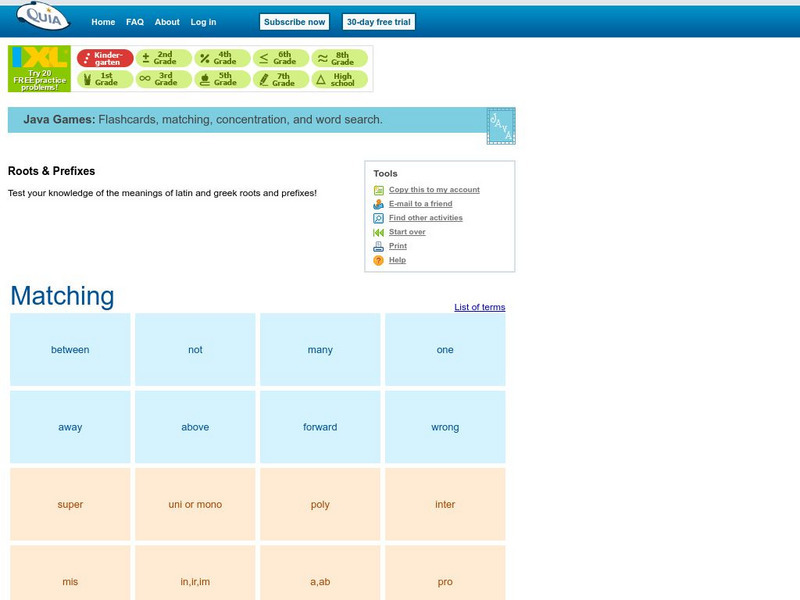
![Holt, Rinehart and Winston: Elements of Literature: Ambiguity Chart [Pdf] Graphic Holt, Rinehart and Winston: Elements of Literature: Ambiguity Chart [Pdf] Graphic](http://content.lessonplanet.com/resources/thumbnails/410052/large/bwluav9tywdpy2symdiwmduymc03nza4ltfumdkxegsuanbn.jpg?1589985124)
